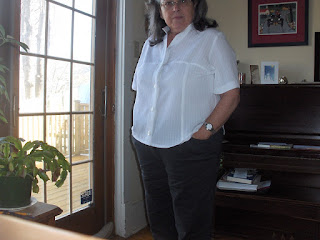As promised, some photos of my two versions of Sonya's Blouse from Silhouette Patterns. I cut size 7W for the first version, it fit everywhere quite well, except that the neckline didn't look like the pattern. So in version #2, I cut a smaller size in the neck and shoulders, then back to the original size everywhere else. This opens up the neckline so that it looks more like the pattern photo.
This pattern is going into the tried-and-true box.
 |
| Version #1 in a lovely cotton shirting from BlackBird Fabrics |
 |
| Close-up of neckline |
 |
| Close up of neckline, cut in a smaller size |
 |
| Blurry photo of version #2 |
 |
| Better photo of version #2 |
 |
| Standard photo with hands on hips |
On Saturday afternoon, I decided to listen to one of Peggy Sager's videos about her patterns and fitting. These are available on YouTube, just search for Silhouette Patterns. There are loads of videos on there, some on specific patterns, others on more general topics such as fitting, wardrobing.
Peggy is a real goldmine of information. She began her working career as a pattern maker for a clothing company. It was only after about 15 years doing this, that she crossed over into the sewing world. And she realised that home-sewers were meeting disappointment with their efforts because they had no idea how to fit.
Peggy's patterns are based on garment finished measurements, not on body measurements. The reason for this is that she says we all wear our clothes according to how much ease we like in them. And no one can tell you how you like your clothes to fit. Only you can do that.
So take a blouse or dress that you like and measure it across the finished bust. That is the size you choose when sewing Peggy's patterns. Then she provides different bodices for B, C, and D bra cup sizes.
Her explanation of the three elements of fit was very enlightening to me. She says keep in mind, three things - L, C and D. L is length, this is the first thing you alter. The old, measure your back waist length and alter the pattern to fit that. Then C is circumference, this will ensure that the garment will fit or close over your bust or largest area. All other alterations fall into the D category which is depth.
Anything that is angled on a pattern is something that affects the depth. So the angled shoulder line is depth. Peggy explained brilliantly how the shoulder line is actually a dart worked into the pattern. Bust darts are obvious angled lines, but so are princess lines, crotch curves. All of these fall into the third area of fitting. Length and circumference are done first. Then you make a muslin and work on the depth changes.
It all sounded so simple to me when I listened. But I know that there is a learning curve and, as Peggy says, we have listened to the wrong advice for so long, that it is hard to rewire our brains. So I am going to give this a try.
She suggests taking her Classic Blouse, one that I have made twice already, and cutting out just the front and back in a knit fabric. Yes, you can check the fit of a woven blouse by sewing it in a knit. Peggy suggests cutting it one size smaller than the finished measurements of something you wear, the knit will provide stretch, and cut the armhole for a smaller size, which will make the change necessary for a sleeveless garment. That armhole should be cut higher up, in order to bring the armhole up underneath your arm and prevent gaping. Sleeves require more room to be set in, a sleeveless garment doesn't need that room.
She suggests taking her Classic Blouse, one that I have made twice already, and cutting out just the front and back in a knit fabric. Yes, you can check the fit of a woven blouse by sewing it in a knit. Peggy suggests cutting it one size smaller than the finished measurements of something you wear, the knit will provide stretch, and cut the armhole for a smaller size, which will make the change necessary for a sleeveless garment. That armhole should be cut higher up, in order to bring the armhole up underneath your arm and prevent gaping. Sleeves require more room to be set in, a sleeveless garment doesn't need that room.
So I am going to give this a try. The result is that you end up with a nice tank top, that has shaping because the pattern has both front and back vertical darts, plus a bust dart. For the raw edges, simply turn them under and topstitch without stretching the curve.
This all makes so much sense to me. I think I am going to be listening to more of Peggy's videos in the future and trying more of her patterns. After all, she has the vast experience to know what she is talking about.


Listening to Peggy has absolutely turned my sewing around for the better, I am so glad for her teaching on fitting. I just received her Classic Blouse in the mail & that is on the docket for this week, her Yoga Pants were absolutely amazing right out of the packet. I am hoping my blouse turns out half as well as yours, yours is so pretty. Thank you so much for sharing!
ReplyDeleteWhat a great top!
ReplyDeleteHer sewing techniques are novel as well, all industrial shortcuts, things turn out really well.
ReplyDeleteYour blouses are lovely! So nice when a pattern works out.
ReplyDeleteI have been listening to Peggy's videos for years.They are full of information and ideas. She shares her knowledge and truly wants you to "get it".